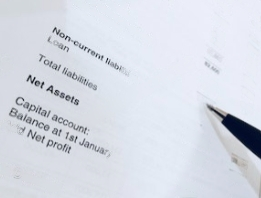Have you ever wondered what drawings in accounting are? Have you seen the term ‘drawings’ appear in a financial statement and wanted to know more?

Drawing is an important concept within accounting, and understanding it is crucial for any business or individual looking at their finances. It involves withdrawals made by a company’s owners, shareholders, or partners as reimbursement for their expenses. This article will cover what drawings are and their purpose in accounting.
Overview Of Drawings In Accounting
Drawing in accounting refers to withdrawing resources from a business for personal use. This includes taking money out of a company’s bank account, using company assets for personal reasons or buying goods or services on behalf of the owner without reimbursing the business.
Drawings are not considered expenses and are recorded separately from regular transactions.
Keeping track of drawings is important because it helps business owners understand how much money they have taken from their companies and how much is left over for reinvestment in their businesses.
Failure to accurately record drawings can affect financial statements such as balance sheets and income statements, leading to inaccurate evaluations of a company’s financial health.
To properly record drawings, businesses must maintain accurate records, including all transactions affecting their accounts.
Personal Expense Vs Business Expense
When managing finances, separating personal and business expenses is crucial for accounting accuracy. If you’re not carefully distinguishing between personal and business expenses, you could be overpaying taxes or underreporting income.
One common area where this confusion arises is withdrawing accounts. Business owners use a drawing account to withdraw money from their company for personal use. It’s important to note that while funds may be taken out of the company through a drawing account, these transactions are considered distributions rather than expenses.
On the other hand, business expenses are recorded in their own account classification. For example, the business inquired and paid a utility bill worth £1,200. With expense transactions, the payment would require a debit in the Utilities Expense account and a credit in cash.
Remember that if the cash is used for personal use, it would be a debit to that shareholder’s Drawings account. But if the cash were used for paying off expenses for business use, then it would be a debit to its particular expense account.
Importance And Purpose Of Drawing Accounts
The benefits of maintaining a drawing account go beyond just keeping track of expenses. It allows you to clearly understand your cash flow, making it easier to manage your finances effectively.
One key benefit of having a drawing account is the ability to separate personal and business expenses. This helps create an accurate picture of the financial health of your business by ensuring that all transactions are accounted for separately. Moreover, this separation minimises the risk of mistakenly using funds for the business on personal expenses.
Another important reason why drawing accounts matters is when it comes to tax season. By carefully documenting all transactions through your drawing account, you can easily identify deductible expenses, which could save you significant amounts on taxes at year-end.
Effects Of Drawings On Financial Statements
Drawing on a business account is often seen in small businesses and sole proprietorships where there is no clear distinction between the owner’s finances and the business’s. However, it is important to understand drawings’ impact on financial statements.
The effect of drawings on financial statements is a reduction in retained earnings. Retained earnings refer to profits earned by a company that are not distributed as dividends but are kept within the company for future growth or use. This decrease can affect investor confidence and make it difficult for companies to secure financing.
Recording And Journalizing Drawing Accounts
Recording withdrawal transactions properly is crucial for maintaining accurate financial records and making informed decisions about your business’s future.
To record drawings in accounting, you need to create a journal entry that reflects this transaction. The first step is to debit the owner’s drawing account by the amount withdrawn. This will show that there has been a reduction in the company’s equity due to the withdrawal made by the owner.
Next, you must credit your bank account if cash was withdrawn or any other relevant account if goods or services were removed.
For example, John Smith is a shareholder in ABC Company. On January 1, 2023, he withdrew £500 from his capital for personal purposes. To record the transaction, the entry should be:
Dr. J. Smith, Drawings 500
Cr. Cash (on Bank) 500
Tips On Managing Drawing Accounts
Keeping track of these withdrawals can be tricky, especially if you have multiple accounts or make frequent transactions.

One way to manage your drawings is by keeping a record of all withdrawals made from each account. This can be done manually using a notebook or spreadsheet or through online banking platforms that allow you to view transaction history and print statements.
By recording each withdrawal, you can easily see how much money has been taken out and when it was withdrawn, which can help you budget better and avoid overspending.
Then, set up separate accounts for your business and personal finances. It’s crucial to segregate your funds as this will help you avoid confusion between your personal and business expenses. You should also consider setting up a budget for both accounts to manage your finances better.
Another effective way to manage your drawings is limiting how much money you withdraw each week or month.
Conclusion
In conclusion, drawings in accounting are an important financial tool for businesses of all sizes. They provide owners and partners with the resources to manage their finances and daily operations.
Drawings allow business owners to withdraw funds from a company without paying taxes and provide incentives to stay invested in their business. Accountants must be aware of these regulations when preparing drawings for their clients to ensure accuracy and familiarity with the law.
FAQS
Are there tools to easily manage drawings in accounting?
Yes, there are several tools available to help manage drawings in accounting.
The first is an accounting software package like Xero that will allow you to track and record all the details related to drawings, such as who drew what amount and when.
Another option is to use an online service that offers automatic reminders when it’s time to draw and easy-to-understand visualisations of your drawing activity, so you can quickly identify trends or areas where adjustments may be needed.
What is a common mistake made with drawings in accounting?
One of the most common mistakes made with drawings in accounting is not recording them correctly. Drawings are amounts taken from a business’s capital account for personal use by owners or shareholders and should be recorded as deductions from the capital account. If these deductions are not accurately recorded, it can lead to incorrect financial statements and an inaccurate understanding of the business’s financial position.
Are drawing balances included in the Income Statement?
The Income Statement is a financial statement showing a company’s revenues and expenses over a year, typically one year. Drawing balances are not considered part of the company’s regular income and expenses, so it is not included in the Income Statement. Instead, drawing balances are reported on the company’s Balance Sheet as an equity account. This helps ensure that the company’s financial statements accurately reflect its performance and profitability.






